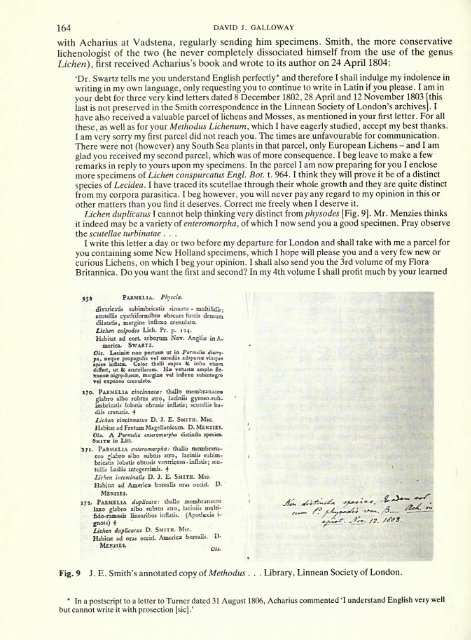British Museum (Natural History)
British Museum (Natural History)
British Museum (Natural History)
Create successful ePaper yourself
Turn your PDF publications into a flip-book with our unique Google optimized e-Paper software.
164 DAVID J. GALLOWAY<br />
with Acharius at Vadstena, regularly sending him specimens. Smith, the more conservative<br />
lichenologist of the two (he never completely dissociated himself from the use of the genus<br />
Lichen), first received Acharius's book and wrote to its author on 24 April 1804:<br />
'Dr. Swartz tells me you understand English perfectly* and therefore I shall indulge my indolence in<br />
writing in my own language, only requesting you to continue to write in Latin if you please. I am in<br />
your debt for three very kind letters dated 8 December 1802, 28 April and 12 November 1803 [this<br />
last is not preserved in the Smith correspondence in the Linnean Society of London's archives]. I<br />
have also received a valuable parcel of lichens and Mosses, as mentioned in your first letter. For all<br />
these, as well as for your Methodus Lichenum, which I have eagerly studied, accept my best thanks.<br />
I am very sorry my first parcel did not reach you. The times are unfavourable for communication.<br />
There were not (however) any South Sea plants in that parcel, only European Lichens - and I am<br />
leave to make a few<br />
glad you received my second parcel, which was of more consequence. I beg<br />
remarks in reply to yours upon my specimens. In the parcel I am now preparing for you I enclose<br />
more specimens of Lichen conspurcatus Engl. Bot. t. 964. 1 think they will prove it be of a distinct<br />
species of Lecidea. I have traced its scutellae through their whole growth and they are quite distinct<br />
from my corpora parasitica. I beg however, you will never pay any regard to my opinion in this or<br />
other matters than you find it deserves. Correct me freely when I deserve it.<br />
Lichen I duplicatus cannot help thinking very distinct from physodes [Fig. 9]. Mr. Menzies thinks<br />
it indeed may be a variety of enteromorpha, of which I now send you a good specimen. Pray observe<br />
the scutellae turbinatae . . .<br />
I write this letter a day or two before my departure for London and shall take with me a parcel for<br />
you containing some New Holland specimens, which I hope will please you and a very few new or<br />
curious Lichens, on which I beg your opinion. I shall also send you the 3rd volume of my Flora<br />
Britannica. Do you want the first and second? In my 4th volume I shall profit much by your learned<br />
S3 PARMELIA. Pfyscia.<br />
divaricatis subimbricatis sinuato - multifidU;<br />
scutellis cyathiformibus<br />
obscure fuscis demum<br />
dilatatis, infiexo crenulato.<br />
margine<br />
Lichen colpodet<br />
Lich. Pr. p. 124.<br />
Habitat ad cort. arbormn Nov. Angliae in A.<br />
merica. SWARTZ.<br />
O4*. Laciniz non pertusz ut in Parmelia diatry.<br />
fd, Deque propagulis vtl sorediis adspersz vixrjue<br />
apice inflate. Color thalli supra 8c infra etiam<br />
differt, ut fc scutellarum. Hx vetustz amplae fle<br />
xuosz nigro-fuscjc, margine vel infiexo sulnategro<br />
vel expanse crenulato.<br />
170. PARMELIA cinclnnata: thallo membraruceo<br />
glabro albo subtut atro, laciniis gyroso-subimbricatis<br />
lobatii obtusis infLitis; scutellis ba-<br />
cliis crenatis. -f<br />
Lichen cincinnatut D. J. E. SMITH. Msc.<br />
Habitat ad Fretum Magelianicum. D. MENZIES.<br />
O.'s. A Parmelia enttromorpha distindi species.<br />
SMITH in Litt.<br />
Syi. PARMELIA enteromorpha: thallo membranaceo<br />
rlibro *!bo subtus atro, laciniis subimbricatis<br />
lobatis obtusis ventricoso - inflatis ; scu-<br />
tellis Ladiis mtegerrimis. 4<br />
Lichen ititcttinalis D. J. E. SMITH. Msc.<br />
Habitat ad America: borealis oras occid. D.<br />
MENZIES.<br />
173. PARMELIA thallo znembranacco<br />
duplicata:<br />
laxo ghbro albo subttis atro, laciniis multtfjdo-ramosis<br />
linearibus inflatis. (Apothccia i-<br />
gnota) 4<br />
Lichen duplicatut D. SMITH. Msc.<br />
Habitat ad oras occid. America: borcalis. D-<br />
MEKZIES.<br />
Fig. 9 I.E. Smith's annotated copy of Methodus . . . Library, Linnean Society of London.<br />
* In a postscript to a letter to Turner dated 31 August 1806, Acharius commented 'I understand English very well<br />
but cannot write it with prosection [sic].'

















